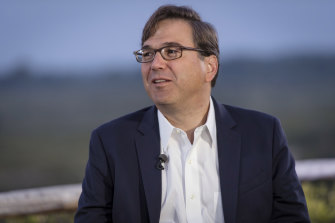“There is just too much stimulus in the pipeline and they are going to have to act much more forcibly. I lose sleep thinking the Fed is way behind the curve,” he said.
Furman said that inflation is being driven first and foremost by excess demand and liquidity in the economy, rather than by supply-chain disruptions or higher energy prices, as the Fed argued fervently until late last year. The institution has badly misjudged the calibration of stimulus.
It predicted inflation this year of 2.2 per cent as recently as December, but the figure is already running at a 40-year high of 8.5 per cent. The Fed staff relied on a New Keynesian Phillips Curve model that omits most of the key ingredients in price shocks and is “incapable of predicting any inflation,” said Furman.

Former chairman of the White House Council of Economic Advisers Jason Furman says the Fed has been “badly burned” and is now making up for lost time. Credit:Bloomberg
Gita Gopinath from the International Monetary Fund said that what began as a global supply shock during the pandemic has metamorphosed into something closer to a (positive) demand shock with its own self-feeding momentum, which central banks cannot safely allow to run unchecked.
“Over the last three months broad-based inflation has spilled through the global economy and we’re seeing it much more widely,” she said in Davos.
“The surprise element has been that we’ve been used, over the last decade, to living in a world where we worried about demand being too low. Then you get hit by the pandemic and you have major global supply shocks.”
It has been a nightmare for central banks to figure out where the proper balance lies between demand and supply in such a fast-moving and turbulent picture.
Loading
Correcting for past mistakes – or over-correcting, in the view of monetarists – the Fed now seems determined to rein in inflation whatever the economic cost. It is raising rates in 50 point chunks and has swung abruptly from asset purchases to asset sales, targeting quantitative tightening (reverse QE) of $US95 billion ($133 billion) a month by September.
Columbia professor Adam Tooze said some are muttering sotto voce in Davos that the Fed may have “turned Frankenstein on the markets”. Having bathed investors and the owners of wealth with abundant liquidity for years, it is now targeting its monetary squeeze on the same economic elites. What QE giveth, QT taketh away.
Bill Dudley, ex-head of the New York Fed, said the institution is actively attempting to deflate Wall Street equities in order to help break the back of inflation through the mechanism of the wealth effect. It is “front-loading” rate rises across the maturity spectrum with hawkish rhetoric, forcing the markets to price in tough action before it even occurs.
Even so, the Fed may not yet have gone far enough. Dudley said it should come clean and admit that rates are going to 4 per cent or even 5 per cent even if that means a likely recession, rather than “sugar coating” its message. The federal funds rate is currently still just 1 per cent, and markets expect it to reach 3 per cent by the end of the year.
Not everybody agrees that a monetary purge of such ferocity is either necessary or wise. Scott Minerd from Guggenheim Partners said in Davos that the “neutral rate” is lower than the Fed thinks, and warned that the leveraged loan market is already cracking as the economy rolls over.

Fed chair Jerome Powell has been heavily criticised for not acting sooner to fight oinflation. Credit:AP
Nobel economist Joe Stiglitz said higher rates might actually make inflation worse by curbing the very investment needed to repair damage to global supply chains and productive capacity.
But the doves are being drowned out by a chorus of voices demanding tough love, even in Europe where most of this year’s one-off jump in the price level is indisputably caused by an imported energy and trade shock.
Klaas Knot, Holland’s ECB governor and head of the global Financial Stability Board, said there are signs that inflation expectations in the eurozone are becoming “de-anchored”. The 10-year measure was 1.9 per cent last November: it was 2.4 per cent in May. “There is a considerable drift upwards,” he said.
“The ‘Fed Put’ is over. They don’t mind what happens to markets…They haven’t done enough yet to prepare people,”
Jason Furman, former chairman of the White House Council of Economic Advisers.
“As a central bank, we’re not looking at energy prices. That is yesterday’s news, water under the bridge. But the components of underlying inflation are all going north-east, and the question is where do they stop?” he said in Davos.
Knot said there are early warning signs of an inflationary wage-spiral taking off in Eastern Europe, Germany, the Netherlands and even in Spain.
He said central banks cannot do anything about an imported energy shock, calling it “futile” to tamper with the price signal. “Energy inflation is a trade loss. We have to accept that we have collectively grown poorer,” he said.
Loading
Knot said targeted fiscal help for poor families can be justified as a matter of social justice but it makes absolutely no sense for governments to rush through general stimulus packages, which merely drive inflation higher. “We cannot compensate everybody,” he said.
Telegraph, London








